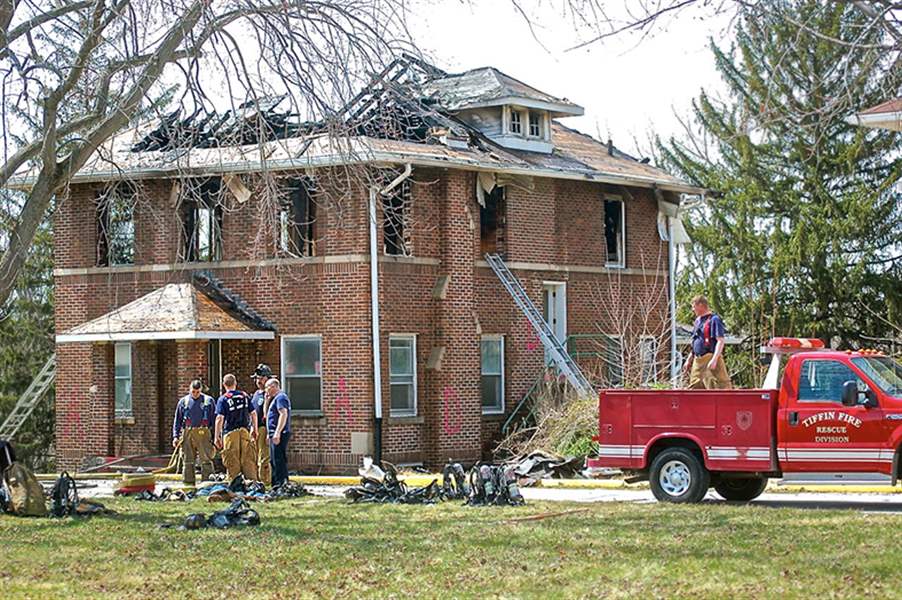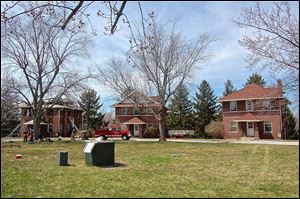
Razing of historic structures begins in Seneca County before approval
Old cottages for orphans in National Register area
4/16/2014
The Tiffin Fire Department conducts exercises on one of the five cottages to be razed at the Tiffin Developmental Center site. Drills on Friday put a hole in the roof and burned the interior.
SPECIAL TO THE BLADE/LISA SWICKARD
Buy This Image

The Tiffin Fire Department conducts exercises on one of the five cottages to be razed at the Tiffin Developmental Center site. Drills on Friday put a hole in the roof and burned the interior.
TIFFIN — A plan to demolish five cottages included in a National Register of Historic Places district has been halted as state officials weigh whether proper channels for razing were followed.
They will consult with the Ohio Historic Preservation Office.
The delay comes after firefighters used one of the cottages, located on a state-owned former orphanage campus in Tiffin, for training exercises last week. The practice drills on Friday created a gaping hole in the structure’s roof and burned its interior.
The preservation office contends that the Ohio Department of Developmental Disabilities, the state agency in charge of the property, did not notify it of plans to tear down the buildings until after one cottage was damaged.
Ohio law directs state agencies to “cooperate” with the nonprofit Ohio Historical Society, which includes the preservation office as a division, regarding such projects, said Amanda Terrell, the office’s director.
“We were not made aware of this, and we were not contacted [about] this until Monday,” Ms. Terrell said. “They explained what they were doing and that they had already demolished one building and had plans to demolish the rest.”
A spokesman with the developmental disabilities department said an agency representative emailed the historical society sometime “in the first half” of last year but received no response. A copy of the email could not be immediately accessed or provided because of changes to the department’s email system, spokesman Kerry Francis said.
No one in the department followed up because they did not think the buildings in question were part of the National Register listing, Ms. Francis said.
The department contacted the preservation office this week after fielding a reporter’s questions about the demolition plans.
“We appreciate having it brought to our attention that there are additional steps that we have to go through,” Ms. Francis said.
The preservation office will review the plans, which call for the removal of a total of six buildings the department says it no longer needs. The state can’t be forced to keep the structures, but Ms. Terrell wants to discuss alternatives such as leasing the buildings or finding other uses.
Ohio law doesn’t spell out the process to be followed in such situations, and she said there are no repercussions for failure to notify the preservation office.
Evolving needs
“That’s why we have to rely on agencies to make a good-faith effort to comply with the spirit of the law, and we really encourage them to contact us in advance,” she said.
The nearly 650-acre property along the Sandusky River in Seneca County has evolved to suit society’s changing needs, first providing a home for fatherless children and now for those with developmental disabilities.
Since its founding as the National Orphans’ Home in 1896, the site has played an important role in the local history and lives of roughly 5,000 “home kids” sent there after the death of one or both parents.
The fraternal organization Junior Order of United American Mechanics supported the home until it closed in 1944, as Social Security phased out its use for orphanages.
The state purchased the property, and it functioned as an epilepsy center and then a state hospital before the state-run Tiffin Developmental Center began providing a residence in 1981 for people who have developmental disabilities.
The five cottages to be demolished were built in the 1920s. An old clinic, built in 1958, also will be removed.
Residents dwindle
The state contends the vacant cottages are not needed. In the last decade, the center’s residential numbers dropped by almost half to about 100, a trend reflected throughout the country as those with disabilities move into smaller homes or independent-living arrangements, Ms. Francis said.
The cottages lack fire alarms and sprinkler systems and will have no heat once a boiler system is decommissioned. The two-story structures also aren’t accessible to residents who use wheelchairs.
“The buildings are 92 years old, and they don’t meet current code for a lot of areas,” Ms. Francis said. “Any money that we would divert to rehabbing and maintaining those buildings would significantly detract from the programs and services [we] could offer to residents.”
Ms. Francis could not estimate how much it would cost to bring the buildings up to code.
The Tiffin Fire/Rescue Division asked last year to use the structures for training, a practice that helps build firefighters’ confidence and skills, said Chief William Ennis.
Other area departments also will participate.
Once firefighters finish their drills, rubble will be removed at an estimated cost of less than $7,000 for each building, officials said.

The 1920s-era cottages lack fire alarms and sprinkler systems and are not wheelchair-accessible. The site began in 1896 as an orphanage and evolved with the times, becoming a residence for people with developmental disabilities in 1981.
Former National Orphans’ Home residents and their descendants reunite each year at the old campus, and representatives were informed last summer of the state’s demolition plans, Ms. Francis said.
The National Register added the historic district to its list in 1990.
At the time, the property featured more than 40 structures. Thirty four of those buildings, including the five cottages designed in foursquare and gable-front architectural styles, were deemed to contribute to the site’s historical value.
Historians unhappy
When it was an orphans’ home, food came from the surrounding farm and gardens.
The complex had its own school and vocational training in dozens of trades, from cabinet-making to baking, canning, and plumbing. Students could play football, join the student government, and help with the home’s newspaper.
The decision to tear down old structures saddens history lovers, some of whom still mourn the 2012 demolition of the Seneca County Courthouse, part of Tiffin's downtown historic district listed on the National Register.
“I’m a historian by trade and a preservationist, so it’s always upsetting to see structurally sound buildings being destroyed,” said Tricia Valentine, author of Don’t Call Us Orphans, a book about the home.
“It’s sad too for the home kids. I’ve spoken with many of them, and it feels like every little piece is slipping away from them,” she said.
The five doomed cottages are named West Virginia, Virginia, Michigan, Indiana, and District of Columbia after the states and district where the order’s members raised money to pay for their construction, she said.
John Kindervatter, who came to Tiffin as a 12-year-old orphan in the 1930s, lived in the West Virginia cottage for several years. He recalled the homelike atmosphere and the daily routine of chores, meals, and school.
A matron supervised the children, who slept in a large, open area. He remembered stashing bags of walnuts in the attic. By spring, the nuts were ready to crack open and eat.
Mr. Kindervatter, who now lives in Hamilton Square, N.J., said he’s sad the state plans to demolish the cottages, but he understands the decision in light of finances and the dwindling number of residents living at the center. It’s a large, sprawling campus, and over the years, other campus buildings have been lost.
“They’ve got a big piece of property, and it’s logical if they are trying to raise money and become more efficient,” he said.
Contact Vanessa McCray at: vmccray@theblade.com or 419-724-6065, or on Twitter @vanmccray.